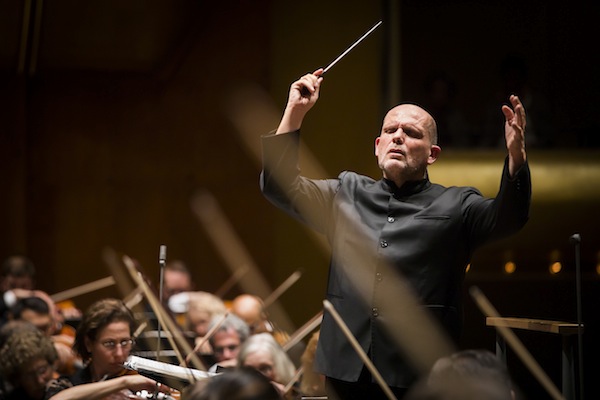Lack of fire makes for objective start to Philharmonic’s “Music of Conscience” series

Jaap van Zweden conducted the New York Philharmonic in music of Shostakovich and Beethoven Thursday night at David Geffen Hall. File photo: Chris Lee
Every artist must feel, on some level, that there is a moral component to what he or she does. Nobody works that long and hard to master something without believing the result will do somebody good.
And because, of all the arts, music takes the most direct neurological path to human emotions, the musician’s sense of good (and bad) carries a powerful and complex emotional charge, especially in times of political crisis and moral challenge.
The New York Philharmonic launched its three-week series “Music of Conscience” Wednesday night with two masterworks composed in response to the most world-shattering events of their time. If the performance led by music director Jaap van Zweden was something less than shattering, there is no disputing the stature of the works themselves.
Dmitri Shostakovich composed his String Quartet No. 8—retitled “Chamber Symphony” by Rudolf Barshai in his string-orchestra arrangement—in just three days, after viewing the remains of the city of Dresden, leveled by Allied bombs during World War II. In a singular act of imagination, the composer painted himself into the picture of devastation by obsessive use of his “DSCH” musical monogram and meaningful quotations from his previous works, mingling sympathy for his German former enemies with his own feelings as a composer on the run from Stalin’s thought police.
And speaking of multiple layers of meaning, how about Ludwig van Beethoven’s colossal musical fan letter to revolutionary hero Napoleon Bonaparte, the Symphony No. 3, “Eroica”—which contained a funeral march, as if the idealistic composer already anticipated declaring Napoleon “dead to me” after the latter crowned himself Emperor?
It perhaps couldn’t be helped that Wednesday’s performance of the Shostakovich work—with its fierce allegro, sardonic waltz, and three heartbreaking largos– had a slightly distanced feeling. Although the composer blessed Barshai’s efforts to make an orchestral piece out of his quartet, the arrangement inevitably altered the affect of the original.
Performed by dozens of string players instead of four, the opening Largo fugue on the twisting DSCH motive sounded more languid and thoughtful than tense and anxious. The slashing Allegro molto that followed, while rhythmically alive and superbly coordinated, couldn’t match the raw fury of the quartet version.
Or it didn’t, at least, in this polished but rather cool performance. To appreciate the depth and complexity of the composer’s emotions, a listener needed to do some reading between the bar lines. However, in quiet passages at the end of the Allegro and elsewhere, arranger Barshai sometimes reverted to one player to a part, and extended solos by concertmaster Frank Huang and principal cellist Carter Brey added heart to the proceedings.
Then it was time for Beethoven, our eternal contemporary, with his musical warning about populist leaders who crown themselves Emperor. At least, that is one of innumerable ways to read the “Eroica.” And again, considerable reading-between was required when listening to this accurate, energetic, yet curiously insubstantial performance.
No doubt the plush, leisurely renderings of earlier eras could use the kick in the pants administered by today’s Classical period-instruments orchestras, with their fleet tempos and astringent sound. But this was a revolutionary work about a revolution, so rich in changeable and even contradictory emotions that it didn’t even conform to the accepted style of its own period, as witness the baffled reactions of its first hearers. Something other than a by-the-rulebook 1803 approach seemed called for.
Yet for all his expert twirling of the dials and throwing of cues, one rarely had the feeling that conductor van Zweden was in any way transported by the music, or that he was inspiring the players to be.
That said, this was a faithful rendering of the score, with all the road signs observed. Yes, the long-short, long-short rhythm of the opening theme was rushed, but almost every conductor does that. The funeral march didn’t actually march, but dawdled like a leisurely Largo. And a performance in which the Philharmonic horns didn’t play too loud in passages of mezzo forte and softer would be revolutionary indeed. But in the main, van Zweden and his players presented the audience with a well-shaped object to contemplate.
It’s poor critical form to make invidious comparisons between artists, but sometimes one can’t help it. It may be unfair to the businesslike current occupant of the Philharmonic podium, but it’s like asking someone not to think about an elephant. Say the words “music of conscience” and “New York Philharmonic,” and then try not to think about a certain Black-Panther-hosting, Berlin-Wall-fall-feteing, heart-on-sleeve-wearing maestro of former times.
After intermission Philharmonic CEO Deborah Borda presided over the organization’s annual tribute to retiring members. This time there was just one honoree, the 36-year-veteran violist Judith Nelson, who made her own appeal to conscience, urging the audience to write their school board, member of Congress, and the Secretary of Education in support of music instruction in public schools.
The program will be repeated 7:30 p.m. Thursday and Tuesday and 8 p.m. Saturday. nyphil.org; 212-875-5656.


